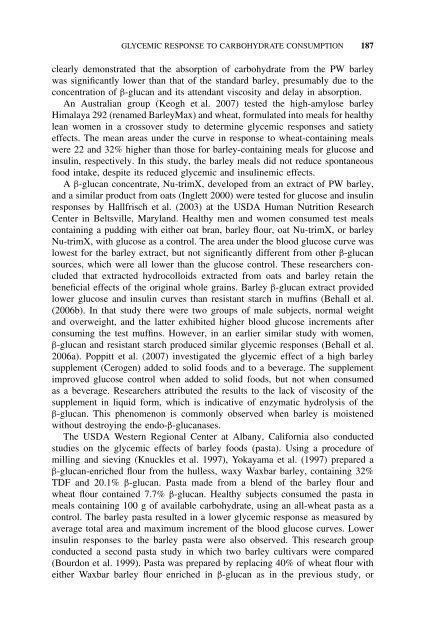Barley for Food and Health: Science, Technology, and Products
Barley for Food and Health: Science, Technology, and Products
Barley for Food and Health: Science, Technology, and Products
You also want an ePaper? Increase the reach of your titles
YUMPU automatically turns print PDFs into web optimized ePapers that Google loves.
GLYCEMIC RESPONSE TO CARBOHYDRATE CONSUMPTION 187<br />
clearly demonstrated that the absorption of carbohydrate from the PW barley<br />
was significantly lower than that of the st<strong>and</strong>ard barley, presumably due to the<br />
concentration of β-glucan <strong>and</strong> its attendant viscosity <strong>and</strong> delay in absorption.<br />
An Australian group (Keogh et al. 2007) tested the high-amylose barley<br />
Himalaya 292 (renamed <strong>Barley</strong>Max) <strong>and</strong> wheat, <strong>for</strong>mulated into meals <strong>for</strong> healthy<br />
lean women in a crossover study to determine glycemic responses <strong>and</strong> satiety<br />
effects. The mean areas under the curve in response to wheat-containing meals<br />
were 22 <strong>and</strong> 32% higher than those <strong>for</strong> barley-containing meals <strong>for</strong> glucose <strong>and</strong><br />
insulin, respectively. In this study, the barley meals did not reduce spontaneous<br />
food intake, despite its reduced glycemic <strong>and</strong> insulinemic effects.<br />
A β-glucan concentrate, Nu-trimX, developed from an extract of PW barley,<br />
<strong>and</strong> a similar product from oats (Inglett 2000) were tested <strong>for</strong> glucose <strong>and</strong> insulin<br />
responses by Hallfrisch et al. (2003) at the USDA Human Nutrition Research<br />
Center in Beltsville, Maryl<strong>and</strong>. <strong>Health</strong>y men <strong>and</strong> women consumed test meals<br />
containing a pudding with either oat bran, barley flour, oat Nu-trimX, or barley<br />
Nu-trimX, with glucose as a control. The area under the blood glucose curve was<br />
lowest <strong>for</strong> the barley extract, but not significantly different from other β-glucan<br />
sources, which were all lower than the glucose control. These researchers concluded<br />
that extracted hydrocolloids extracted from oats <strong>and</strong> barley retain the<br />
beneficial effects of the original whole grains. <strong>Barley</strong> β-glucan extract provided<br />
lower glucose <strong>and</strong> insulin curves than resistant starch in muffins (Behall et al.<br />
(2006b). In that study there were two groups of male subjects, normal weight<br />
<strong>and</strong> overweight, <strong>and</strong> the latter exhibited higher blood glucose increments after<br />
consuming the test muffins. However, in an earlier similar study with women,<br />
β-glucan <strong>and</strong> resistant starch produced similar glycemic responses (Behall et al.<br />
2006a). Poppitt et al. (2007) investigated the glycemic effect of a high barley<br />
supplement (Cerogen) added to solid foods <strong>and</strong> to a beverage. The supplement<br />
improved glucose control when added to solid foods, but not when consumed<br />
as a beverage. Researchers attributed the results to the lack of viscosity of the<br />
supplement in liquid <strong>for</strong>m, which is indicative of enzymatic hydrolysis of the<br />
β-glucan. This phenomenon is commonly observed when barley is moistened<br />
without destroying the endo-β-glucanases.<br />
The USDA Western Regional Center at Albany, Cali<strong>for</strong>nia also conducted<br />
studies on the glycemic effects of barley foods (pasta). Using a procedure of<br />
milling <strong>and</strong> sieving (Knuckles et al. 1997), Yokayama et al. (1997) prepared a<br />
β-glucan-enriched flour from the hulless, waxy Waxbar barley, containing 32%<br />
TDF <strong>and</strong> 20.1% β-glucan. Pasta made from a blend of the barley flour <strong>and</strong><br />
wheat flour contained 7.7% β-glucan. <strong>Health</strong>y subjects consumed the pasta in<br />
meals containing 100 g of available carbohydrate, using an all-wheat pasta as a<br />
control. The barley pasta resulted in a lower glycemic response as measured by<br />
average total area <strong>and</strong> maximum increment of the blood glucose curves. Lower<br />
insulin responses to the barley pasta were also observed. This research group<br />
conducted a second pasta study in which two barley cultivars were compared<br />
(Bourdon et al. 1999). Pasta was prepared by replacing 40% of wheat flour with<br />
either Waxbar barley flour enriched in β-glucan as in the previous study, or

















